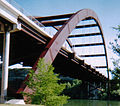- Tied-arch bridge
-
 Fremont Bridge in Portland, Oregon is the second-longest tied arch bridge in the world. In this case the half-arches on either end of the bridge terminate atop slender raised piers. The horizontal forces of the main arch and the outer half-arches balance at the ground level foundations.
Fremont Bridge in Portland, Oregon is the second-longest tied arch bridge in the world. In this case the half-arches on either end of the bridge terminate atop slender raised piers. The horizontal forces of the main arch and the outer half-arches balance at the ground level foundations.
A tied-arch bridge is an arch bridge in which the outward-directed horizontal forces of the arch, or top chord, are borne as tension by the bottom chord (either tie-rods or the deck itself), rather than by the ground or the bridge foundations. Thrusts downward on such a bridge's deck are translated, as tension, by vertical ties of the deck to the curved top chord, tending to flatten it and thereby to push its tips outward into the abutments, like other arch bridges. However in a tied-arch or bowstring bridge, these movements are restrained not by the abutments but by the bottom chord, which ties these tips together, taking the thrusts as tension, rather like the string of a bow that is being flattened. Therefore the design is often called a bowstring-arch or bowstring-girder bridge.[citation needed] The elimination of horizontal forces at the abutments allows tied-arch bridges to be constructed with less robust foundations; thus they can be situated atop elevated piers or in areas of unstable soil.[1] In addition, since they do not depend on horizontal compression forces for their integrity, tied-arch bridges can be prefabricated offsite, and subsequently floated, hauled or lifted into place. A notable case of these procedures was the installation of the Fremont Bridge in Portland, Oregon.
Issues
In a 1978 advisory issued by the Federal Highway Administration (FHWA), the FHWA noted that tied-arch bridges are susceptible to problems caused by poor welds at the connection between the arch rib and the tie girders, and at the connection between the arch and vertical ties. In addition, problems with electroslag welds, while not isolated to tied-arch bridges, resulted in costly, time-consuming and inconveniencing repairs. The structure as a whole was described as nonredundant; failure of either of the two tie girders would result in failure of the entire structure.[2]
References
- ^ For a nontechnical exposition, see Gordon, JE (1978). Structures; or Why Things Don't Fall Down. London: Penguin Books. p. 208f. ISBN 9780306400254. OCLC 4004565.
- ^ Federal Highway Administration (1978-09-28). "TIED ARCH BRIDGES: T 5140.4". http://www.fhwa.dot.gov/legsregs/directives/techadvs/t514004.htm. Retrieved 2008-07-22.
Gallery of tied-arch bridges
-
The Hoan Bridge is a tied-arch bridge, carrying Interstate 794 over the Milwaukee River in Milwaukee, Wisconsin. -
Pennybacker Bridge is a traditional arch bridge. Note that the arches terminate at ground-level abutments, which provide the squeezing force which holds the bridge up. -
The Fort Pitt Bridge is a tied-arch bridge. Note that the arches terminate atop slender raised piers, which provide no squeezing force; tension in the road deck holds up the arch. -
The under-construction Haggerston bridge will carry the London Overground across the Regent's Canal from 2010.
-
The Blackfriars Street Bridge is an 1875 cast-iron structure, still carrying motor and pedestrian traffic in the center of London, Ontario, Canada.
-
Windsor Railway Bridge designed by Brunel and built in 1849.
-
Braunstone Gate Bridge once carried the main line of the Great Central Railway from Manchester to London, demolished autumn 2009.
-
The Blue Water Bridge second span (in foreground) built in 1997.
Categories:- Tied arch bridges
- Bridges
Wikimedia Foundation. 2010.










